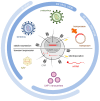Engineering strategies to safely drive CAR T-cells into the future
- PMID: 38962002
- PMCID: PMC11219585
- DOI: 10.3389/fimmu.2024.1411393
Engineering strategies to safely drive CAR T-cells into the future
Abstract
Chimeric antigen receptor (CAR) T-cell therapy has proven a breakthrough in cancer treatment in the last decade, giving unprecedented results against hematological malignancies. All approved CAR T-cell products, as well as many being assessed in clinical trials, are generated using viral vectors to deploy the exogenous genetic material into T-cells. Viral vectors have a long-standing clinical history in gene delivery, and thus underwent iterations of optimization to improve their efficiency and safety. Nonetheless, their capacity to integrate semi-randomly into the host genome makes them potentially oncogenic via insertional mutagenesis and dysregulation of key cellular genes. Secondary cancers following CAR T-cell administration appear to be a rare adverse event. However several cases documented in the last few years put the spotlight on this issue, which might have been underestimated so far, given the relatively recent deployment of CAR T-cell therapies. Furthermore, the initial successes obtained in hematological malignancies have not yet been replicated in solid tumors. It is now clear that further enhancements are needed to allow CAR T-cells to increase long-term persistence, overcome exhaustion and cope with the immunosuppressive tumor microenvironment. To this aim, a variety of genomic engineering strategies are under evaluation, most relying on CRISPR/Cas9 or other gene editing technologies. These approaches are liable to introduce unintended, irreversible genomic alterations in the product cells. In the first part of this review, we will discuss the viral and non-viral approaches used for the generation of CAR T-cells, whereas in the second part we will focus on gene editing and non-gene editing T-cell engineering, with particular regard to advantages, limitations, and safety. Finally, we will critically analyze the different gene deployment and genomic engineering combinations, delineating strategies with a superior safety profile for the production of next-generation CAR T-cell.
Keywords: CAR T-cells; cell engineering; gene editing; gene modification; transgene delivery.
Copyright © 2024 Rossi and Breman.
Conflict of interest statement
All authors involved in the manuscript were employees of Celyad Oncology SA at the time of writing the manuscript.
Figures


Similar articles
-
Use of Cell and Genome Modification Technologies to Generate Improved "Off-the-Shelf" CAR T and CAR NK Cells.Front Immunol. 2020 Aug 7;11:1965. doi: 10.3389/fimmu.2020.01965. eCollection 2020. Front Immunol. 2020. PMID: 32903482 Free PMC article. Review.
-
Building Potent Chimeric Antigen Receptor T Cells With CRISPR Genome Editing.Front Immunol. 2019 Mar 19;10:456. doi: 10.3389/fimmu.2019.00456. eCollection 2019. Front Immunol. 2019. PMID: 30941126 Free PMC article. Review.
-
CRISPR/Cas9 and CAR-T cell, collaboration of two revolutionary technologies in cancer immunotherapy, an instruction for successful cancer treatment.Hum Immunol. 2018 Dec;79(12):876-882. doi: 10.1016/j.humimm.2018.09.007. Epub 2018 Sep 24. Hum Immunol. 2018. PMID: 30261221 Review.
-
Engineering the next-generation of CAR T-cells with CRISPR-Cas9 gene editing.Mol Cancer. 2022 Mar 18;21(1):78. doi: 10.1186/s12943-022-01559-z. Mol Cancer. 2022. PMID: 35303871 Free PMC article. Review.
-
CRISPR/Cas systems to overcome challenges in developing the next generation of T cells for cancer therapy.Adv Drug Deliv Rev. 2020;158:17-35. doi: 10.1016/j.addr.2020.07.015. Epub 2020 Jul 21. Adv Drug Deliv Rev. 2020. PMID: 32707148 Free PMC article.
Cited by
-
Advanced delivery systems for gene editing: A comprehensive review from the GenE-HumDi COST Action Working Group.Mol Ther Nucleic Acids. 2025 Jan 17;36(1):102457. doi: 10.1016/j.omtn.2025.102457. eCollection 2025 Mar 11. Mol Ther Nucleic Acids. 2025. PMID: 39991472 Free PMC article. Review.
-
State of the art in CAR-based therapy: In vivo CAR production as a revolution in cell-based cancer treatment.Cell Oncol (Dordr). 2025 Aug;48(4):859-883. doi: 10.1007/s13402-025-01056-7. Epub 2025 Apr 22. Cell Oncol (Dordr). 2025. PMID: 40261561 Free PMC article. Review.
-
Next-Generation CAR-T and TCR-T Cell Therapies for Solid Tumors: Innovations, Challenges, and Global Development Trends.Cancers (Basel). 2025 Jun 11;17(12):1945. doi: 10.3390/cancers17121945. Cancers (Basel). 2025. PMID: 40563595 Free PMC article. Review.
-
Egg Cooling After Oviposition Extends the Permissive Period for Microinjection-Mediated Genome Modification in Bombyx mori.Int J Mol Sci. 2024 Nov 25;25(23):12642. doi: 10.3390/ijms252312642. Int J Mol Sci. 2024. PMID: 39684354 Free PMC article.
-
Revolutionizing Autoimmune Kidney Disease Treatment with Chimeric Antigen Receptor-T Cell Therapy.Research (Wash D C). 2025 May 22;8:0712. doi: 10.34133/research.0712. eCollection 2025. Research (Wash D C). 2025. PMID: 40405911 Free PMC article. Review.
References
Publication types
MeSH terms
Substances
LinkOut - more resources
Full Text Sources

